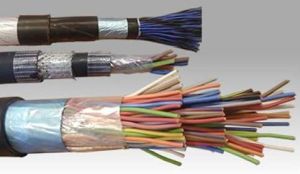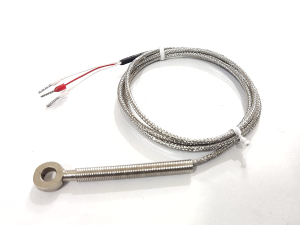





Control Panel
7,500 - 8,000 Per Piece

Instrumentation Cables
Get Price Quote
Excelling in offering Instrumentation Cables to our customers, we aim to be the best in the industry. Applied in normal or hazardous areas and suitable in process control, A/D converters and other modern microprocessor based instrumentation circuits, they are available with or without flame retardant properties. Their excellent noise resistance and induction resistance are a result of perfect designing for use in instrumentation circuits.Specification : Voltage grade 650/1100 Volts (Uo/U). Conforming to standard specifications like - IS 5608, I, II, III, BS 5308 Pt-1, BS 1584 Pt1, 2, 3, IEC 189-5 Pt-3, BS 6360, BS 5099Pt-2.Configuration : Multi-core / multi-pair / multi-quad laid up concentrically or in units. Conductor : Solid / stranded, tinned / bare / silver-plated annealed high conductivity EC grade copper, sizes ranging from 0.5 sq. mm to2.5 sq. mm. Insulation : PVC/ Solid PE/ special thermoplastic materials, heat resistant PVC-85ºC/105ºC operation. Halogen free polymeric or elastomeric insulation can be provided. Core identification by color-coding or printed numeral/letter. Core-Wrap : One or more Plastic Tape. Screen : Cores/Pairs/Quads can be individually or overall screened or both. Screening by Cu/Al-Mylar Tape or copper braid or Aluminum wire for reinforced Armor types. Drain Wire : Drain -Wire of solid/stranded, bare/tinned copper wire normally provided with both individual and overall screen. Mechanical Protection : Cables can be armored with galvanized steel wires & strips or double helical steel tape. Inner and Outer Sheath : PVC Black/Grey.HR/FRLS PVC Sheathing or Halogen Free polymeric/elastomeric sheathing also available.Additional Feature Communication Pair Bicolor Extrusion, Band Marking can be provided on request. Designed to combat all the basic type of noise which affects process instrument signals viz. static, magnetic, manmade and cross-talk. Reference specification for testing IS:10810, ASTMD2863, ASTMD2843, IEC-754(1), VDE 0815, and VDE 0207(PT5), IEE383, SS-424-14-75(F3), VDE0207 (PT 4), VDE0472, IEEE Transit No.467 and as per customer specification requirement.
Best Deals from Instrumentation Equipment

rtd cable
30 Per Meter

Temperature Sensors
Get Price Quote
We deal in wide range of Temperature Sensors. Right from RTD Sensors and Flexible Thermocouple Wire Sensors, we make available all types of Temperature Sensors. We have updated fabrication facility to come up with Temperature Sensors in different technical specifications. All the accessories are specifically tested for resistance to corrosion, moisture and likewise climatic conditions. Also, they comply with ANSI standards. We believe in offering the best value for money and this makes us a sought-after name as Temperature Sensors Manufacturer, Exporter and Supplier from Haryana. What are the different thermocouple types?A thermocouple is available in different combinations of metals. The four most common calibrations are J, K, T and E. There are high temperature calibrations R, S, and B. Each calibration has a different temperature range and environment, although the maximum temperature varies with the diameter of the wire used in the thermocouple. Although the thermocouple calibration dictates the temperature range, the maximum range is also limited by the diameter of the thermocouple wire. That is, a very thin thermocouple may not reach the full temperature range. How to select a thermocouple type? Because a thermocouple measures in wide temperature ranges and can be relatively rugged, thermocouples are very often used in industry. The following criteria are used in selecting a thermocouple : Temperature range Chemical resistance of the thermocouple or sheath material Installation requirements (may need to be compatible with existing equipment; existing holes may determine probe diameter) How to select a junction type? Sheathed thermocouple probes are available with one of three junction types; grounded, ungrounded or exposed. At the tip of a grounded junction probe, the thermocouple wires are physically attached to the inside of the probe wall. This results in good heat transfer from the outside, through the probe wall to the thermocouple junction. In an ungrounded probe, the thermocouple junction is detached from the probe wall. Response time is slower than the grounded style, but the ungrounded offers electrical isolation. Thermocouple in the exposed junction style protrudes out of the tip of the sheath and is exposed to the surrounding environment. This type offers the best response time, but is limited in use to dry, non-corrosive and non-pressurized applications. Types : A grounded junction is recommended for the measurement of static or flowing corrosive gas and liquid temperatures and for high-pressure applications. The junction of a grounded thermocouple is welded to the protective sheath, giving faster response than the ungrounded junction type. An ungrounded junction is recommended for measurements in corrosive environments where it is desirable to have the thermocouple electronically isolated from and shielded by the sheath. The welded wire thermocouple is physically insulated from the thermocouple sheath by MgO powder (soft). An exposed junction is recommended for the measurement of static or flowing non-corrosive gas temperatures where fast response time is required. The junction extends beyond the protective metallic sheath to give accurate fast response. The sheath insulation is sealed where the junction extends to prevent penetration of moisture or gas which could cause errors. Factors to Consider : Choosing the correct thermocouple requires that you look at a number of factors. For example, a thermocouple, which is used only periodically, may be less expensive, but it may have a shorter life span and require servicing more often. If the thermocouple is intended to be used for long periods without service, it may be necessary to use a thicker gauge of wire and it may be necessary to use a design engineered for a greater degree of protection. Below are some general guidelines to consider when choosing a thermocouple. If you need more help making a decision our knowledgeable sales staff is available to recommend a design which will best suit your application. What are the maximum and minimum temperatures the thermocouple will see? What error tolerances are necessary for your application? What is the Measuring atmosphere?(Corrosive/abrasive/vibrating etc) What is the time response required? Will the thermocouple be used continuously or periodically? Will the thermocouple see bending or flexing during it's life? What is the immersion depth? General Guidelines : Do not allow excessive bending of the thermocouples. Cold working can lower the insulation resistance at certain points causing short circuits or decreased accuracy. Use protection tubes for corrosive atmospheres Always inspect protection tubes when changing thermocouples. Things to look for include cracks, pinholes, contamination, or discoloration. Do not locate the thermocouple too close to a heating element Record the life span and cause of failure for each thermocouple to help track down potential problems. Never apply stress to platinum elements, they are fragile and will break easily at high temperatures.

PT1000 temperature sensor
Get Price Quote
PT1000 temperature sensor, Thermocouple Sensors, Thermocouple Cables

Sensors
Get Price Quote
Sensors, Timers, relay base, Industrial Socket, photo sensors

Tata power solar panels
Get Price Quote
Tata power solar panels, supply tata solar panels